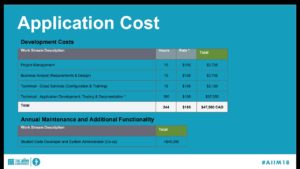I’m in a breakout session at the AIIM 2018 conference, and Kristan Cook and Gina Smith-Guidi are talking about their work at the City of Edmonton in transitioning from network drives to Google Drive for their unstructured corporate information. Corporate Records and Information Management (CRIM) is part of the Office of the City Clerk, and is run a bit independently of IT and in a semi-decentralized manner. They transitioned from Microsoft Office to Google Suite in 2013, and wanted to apply records management to what they were doing; at that time, there was nothing commercially available, so hired a Google Apps developer to do it for them. They needed the usual records management requirements: lifecycle management, disposition and legal hold reporting, and tools to help users to file in the correct location; on top of that, it had to be easy to use and relatively inexpensive. They also managed to reconcile over 2000 retention schedules into one master classification and retention schedule, something that elicited gasps from the audience here.
What they offer to the City departments is called COE Drive, which is a functional classification — it just appears as a folder in Google Drive — then the “big bucket” method below that top level, where documents are filed within a subfolder that represents the retention classification. When you click New in Google Drive, there’s a custom popup that asks for the primary classification and secondary classification/record series, and a subfolder within the secondary classification. This works for both uploaded files and newly-created Google Docs/Sheets files. Because these are implemented as folders in Google Drive, access permissions are applied so that users only see the classifications that apply to them when creating new documents. There’s also a simple customized view that can be rolled out to most users who only need to see certain classifications when browsing for documents. Users don’t need to know about retention schedules or records management, and can just work the way that they’ve been working with Google Drive for five years with a bit of a helper app to help them with filing the documents. They’re also integrating Google File Stream (the sync capability) for files that people work on locally on their desktop, to ensure that they are both backed up and stored as proper records if required.
The COE Drive is a single account drive, I assume so that documents added to the COE Drive have their ownership set to the COE Drive and are not subject to individual user changes. There’s not much metadata stored except for the date, business area and retention classification; in my experience with Google Drive, the search capabilities mean that you need much less explicit metadata.
 It sounds as if most of the original work was done by a single developer, and now they have new functionality created by one student developer; on top of that, since it’s cloud-based, there’s no infrastructure cost for servers or software licences, just subscription costs for Google Apps. They keep development in-house both to reduce costs and to speed deployment. Compare the chart on the right with the cost and time for your usual content and records management project — there are no zeros missing, the original development cost was less than $50k (Canadian). That streamlined technology path has also inspired them to streamline their records management policies: now, changes to the retention schedule that used to require a year and five signatures can now be signed off by the City Clerk alone.
It sounds as if most of the original work was done by a single developer, and now they have new functionality created by one student developer; on top of that, since it’s cloud-based, there’s no infrastructure cost for servers or software licences, just subscription costs for Google Apps. They keep development in-house both to reduce costs and to speed deployment. Compare the chart on the right with the cost and time for your usual content and records management project — there are no zeros missing, the original development cost was less than $50k (Canadian). That streamlined technology path has also inspired them to streamline their records management policies: now, changes to the retention schedule that used to require a year and five signatures can now be signed off by the City Clerk alone.
Lots of great discussion with the audience: public sector organizations are very interested in any solution where you can do robust content and records management using low-cost cloud-based tools, but many private sector companies are seeing the benefits as well. There was a question about whether they share their code: they don’t currently do that, but don’t have a philosophical problem with doing that — watch for their Github to pop up soon!
